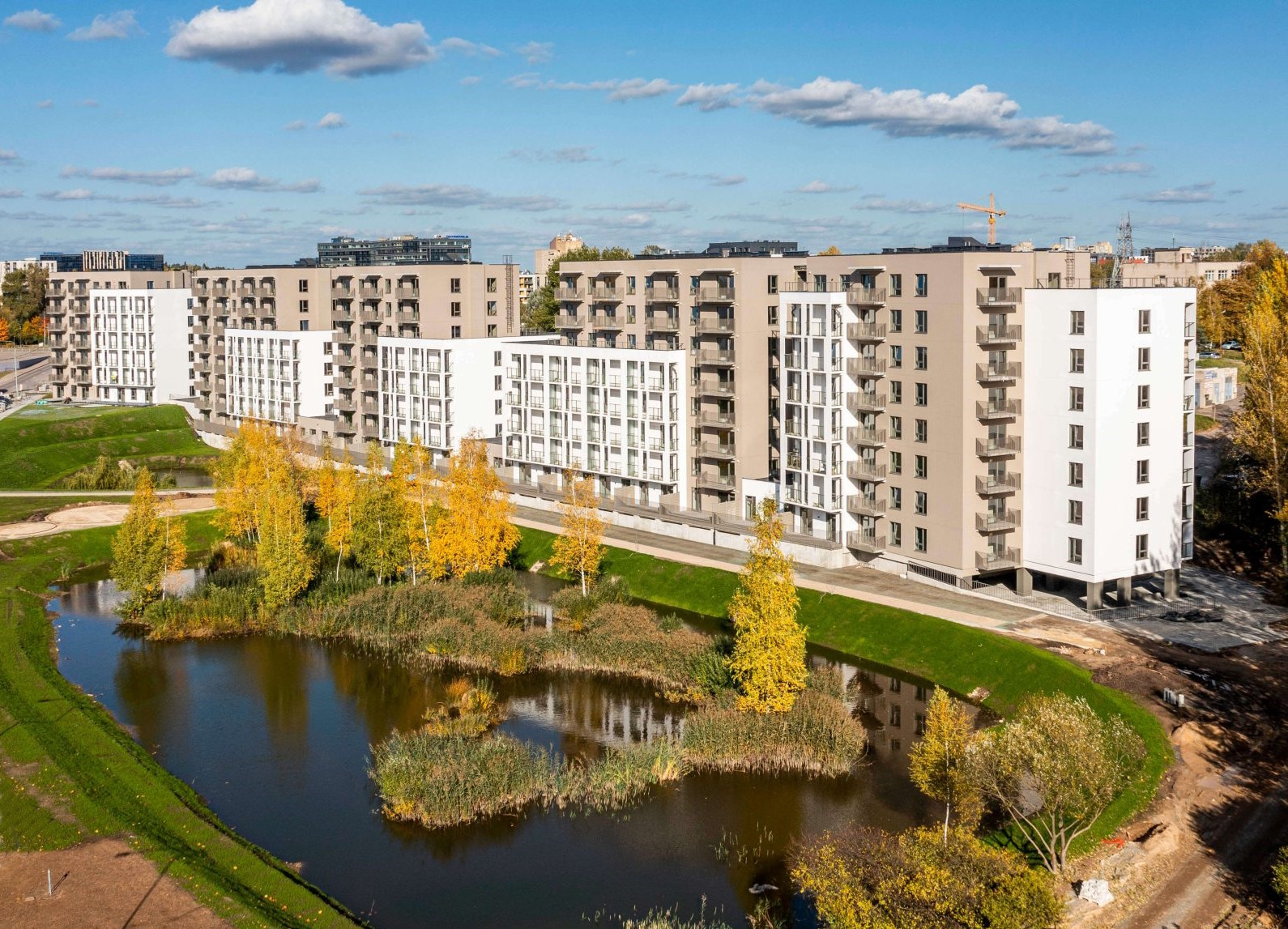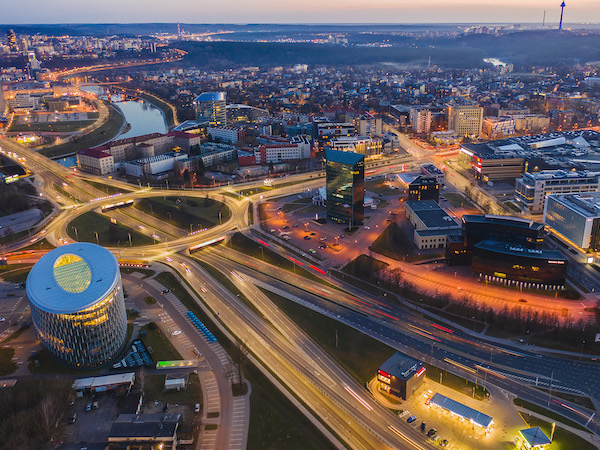Apartment Construction Volumes Remained Stable in Vilnius during 2022, While Record Supply is Forecast in Kaunas in 2023
 The year 2022 was characterised by high volumes of apartment construction in the country’s major cities with a very solid pipeline for 2023. However, due to the economic challenges caused by the war in Ukraine, developers of new housing projects suddenly faced a sharp, unplanned drop in demand. As we can see, demand for housing can suddenly drop but projects that have already started construction cannot be stopped so quickly. Developers themselves have an interest and a commitment to buyers to complete the projects they have begun even when the market is not in the best condition. Therefore, in 2023, housing developers will face significantly more challenges in both completing projects and developing new ones.
The year 2022 was characterised by high volumes of apartment construction in the country’s major cities with a very solid pipeline for 2023. However, due to the economic challenges caused by the war in Ukraine, developers of new housing projects suddenly faced a sharp, unplanned drop in demand. As we can see, demand for housing can suddenly drop but projects that have already started construction cannot be stopped so quickly. Developers themselves have an interest and a commitment to buyers to complete the projects they have begun even when the market is not in the best condition. Therefore, in 2023, housing developers will face significantly more challenges in both completing projects and developing new ones.
According to Ober-Haus data, in 2022, developers in Vilnius built 4,162 apartments for sale, which is 1% more than in 2021. At the beginning of 2022, it was predicted that developers would actually complete the construction of 4,800 apartments during the year, but the final result was ultimately smaller than the forecast. This is not surprising, as construction often takes longer than planned, especially for larger projects or development phases. There are also cases where construction is halted due to legal disputes or project adjustments.
Over the last five years, construction volumes in Vilnius have remained broadly stable, with between 4,100 and 4,400 apartments actually being built for purchase each year. The only exceptional year was 2020, when developers built 5,359 apartments. In 2022, buyers could expect to settle on any of 51 different projects (including continuing phases).
“While 2022 was not an exceptional year for the capital city’s market in terms of the supply for purchase, the number of apartments offered for rent in the market reached a record high. In 2022, three projects (Youston, Shed and Lumi Namai) were completed and opened in Vilnius, offering 580 apartments for long-term rent. Seeing the market demand for professionally managed housing, developers are not only investing in the reconstruction of old buildings and adapting them for rental use, but also building new apartment blocks for this specific purpose,” says Raimondas Reginis, Research Manager for the Baltics at Ober-Haus. The significant addition of new rental housing to the market was particularly timely in 2022, when a large number of people from Ukraine, Russia and Belarus arrived in Lithuania and its capital, and the market faced a sudden surge in demand and rental prices.
2022 saw the largest number of apartments built in three administrative districts of Vilnius
Developers built new apartments in 17 out of 21 administrative districts of Vilnius in 2022. The three of them with the largest share of developers’ attention were Verkiai (15.8%), Lazdynai (15.4%) and Šnipiškės (15.2%), amounting to 46% of the total number of apartments that were built. The Šnipiškės can be singled out as the fastest growing district in Vilnius City. Since 2016, it has been ranked 1-4 among the city’s districts in terms of the volume of apartment construction, and over the last 7 years almost 4,000 apartments have been built for purchase in this area. In 2022, the administrative areas that usually have high construction volumes (Pilaitė and Naujamiestis), did not record many construction projects: Pilaitė had 3.7% and Naujamiestis 2.1%. The high construction volume in the central part of Naujamiestis over the last decade has largely exhausted the development potential (due to the lack of suitable sites for conversion or undeveloped plots), and developers have now shifted their investments to the southern part of this area. Meanwhile, the planned redevelopment of the Vilnius railway station area will provide an additional impetus to the revival of the southern part of Naujamiestis and the Old Town district.
Average size of apartments remains stable with no change expected
Over the last ten years, the average size of flats for sale in apartment buildings in the capital of the country has remained stable and fluctuated around 51-54 sqm. According to Ober-Haus data, in 2022, the average floor area of an apartment in multi-flat buildings built in Vilnius, was 52.2 sqm. “Analysing the projects that are currently under construction or those in the planning stage, it is evident that the average floor area of apartments in the new-build market will not increase in the near future. In fact, more spacious apartments are only being designed in higher class projects, which are usually built in the central part of the city or in prestigious areas,” says Mr Reginis. In 2022, the average size of flats built in the Old Town and New Town districts was 61.7 sqm, while in Žvėrynas, Antakalnis and Šnipiškės districts it was 58.8 sqm. And the apartments with the smallest floor area were built in the remaining part of Vilnius city amounting to 49.1 sqm. Meanwhile, those looking for more spacious and affordable housing, are looking towards the still actively expanding segment of individual or sub-unit residential buildings on the outskirts of the city. For example, in 2022, according to the State Data Agency (formerly the Department of Statistics of Lithuania), Lithuania had a record amount of detached and semi-detached housing built.
Limited numbers of A++ energy class apartment blocks
Despite the fact that the requirement to comply with the A++ energy class for new buildings when applying for a building permit came into force on 1 January 2021, very few these apartment blocks have been built. “The data collected by Ober-Haus show that of the apartments built for sale in Vilnius during 2022, the largest share accounted for A+ energy class apartments at 77.8% (in 2021 the share of A+ energy class was 55.1%), A class were at 12.4% (in 2021 – 33.2%), while the relative share of A++ energy class has even declined to 4.4% (in 2021 – 6.2%). The remaining share of apartments (5.4%) was in energy class B or lower (5.5% in 2021).
“Evidently, developers were reluctant to voluntarily invest in the construction of the highest energy class apartment blocks and had been trying to prepare projects and obtain permits for them before the A++ energy class requirements came into force. For the period 2019–2022, only 2-4 different apartment projects in Vilnius were issued with the highest energy class certificates each year. In 2023, the number of high-energy efficiency class apartment buildings should increase significantly, with the A++ energy class only starting to dominate from 2024-2025,” commented Mr Reginis.
Kaunas gains momentum, while Klaipėda construction volumes remain stable
The continuing construction of apartment blocks in Kaunas during 2022, once again confirmed that the active development of the residential and commercial real estate market in Kaunas, which started in 2016-2017, has gained momentum. According to Ober-Haus data, in 2022, developers in Kaunas built 1,020 apartments for purchase, 8% more than in 2021. This is the highest annual number of apartments built since 2008, when 1,070 new apartments were built in apartment buildings. The geography of apartment buildings under construction in Kaunas is very wide – from newly built apartments on the outskirts of the city to reconstructed or newly developed projects in the central part of the city. In total, in 2022, buyers could settle in any of 27 different projects (including continuing phases of projects). However, in 2022, the two Kaunas administrative districts were the most prominent, accounting for half of all apartments built in Kaunas: Dainava (28%) and Šilainiai areas (22%). “Kaunas has clearly become the second largest construction site after the country’s capital, where not only well-known companies in the local market are operating, but also new, financially strong and well-known developers in Lithuania are gradually arriving. Well established developers have the potential to implement really ambitious real estate projects, to meet the demand for new housing and at the same time to help the city grow,” says Mr Reginis. According to the State Data Agency, over the last five years the number of permanent residents in Kaunas City Municipality alone has increased by 5.8% or almost 16,800 residents.
Meanwhile, 2022 was not an exceptional year for Klaipėda. According to Ober-Haus data, in 2022, developers in Klaipėda built 466 apartments for purchase in apartment buildings, or almost twice as many as in 2021. The solid growth in construction volumes was mainly due to the very low construction volumes in 2021. In contrast, looking at the construction volumes over the last five years, we see that in 2018-2019, more than 400 apartments were built each year, while in 2020-2021, construction volumes slowed down to 320 and 237 apartments respectively. In total, in 2022, buyers in Klaipėda could settle in any of 11 different projects (including the continuing phases of projects). “It is clear that Klaipėda is still lacking larger-scale investments, especially in the central part of the city. There are hopes that the current slowdown in the housing market will not cool down the developers’ determination and we will soon see the start of the implementation of more ambitious residential projects planned in this city”, enthuses Mr Reginis.
Developers will have a lot of work (commitments) on site in 2023
Taking into account the number of apartments currently under construction and their construction stages, Ober-Haus forecasts that in 2023 a total of around 5,200 apartments will be built in Vilnius, or 25% more than in 2022. The current construction of the apartments that will be completed in 2023 was initiated between 2021 and 2022, when the housing market was experiencing its fastest growth period in the last decade. If the projects currently under construction are completed on time, the annual supply in the country’s capital will be among the highest in history.
In 2023, developers in Kaunas will try to surpass all previous supply indicators. In total, about 1,500 apartments are expected to be built in Kaunas this year, or 47% more than in 2022. Historically, this would be an impressive rate and one that has never been recorded before. To date, the highest number of apartments for sale was built in 2008 (1,070 apartments). In terms of the relative number of apartments built (compared to the number of permanent residents), Kaunas will overtake Riga in 2023 and will be the third largest city in the Baltic States (with Vilnius in first place and Tallinn in second).
In 2023, construction volumes in Klaipėda should remain stable and the number of apartments built for sale will be similar to those in 2022 – 450 apartments. “The biggest news in the Klaipėda housing market, is a really ambitious project planned for the Old Town near Jonas’ Hill. The 3.5 ha area will be developed into a multi-apartment quarter christened Bastionų Namai, where over 700 apartments are planned. The project is currently undergoing preparatory work and the first apartment blocks are expected to be built here in 2024,” explains Mr Reginis.
While this year there is a lot of construction planned in the country’s major cities and buyers can be pleased with the abundance of choice, the activity rates in the primary apartment market are a cause for concern for developers. The sharp drop in new apartment sales since the outbreak of the war in Ukraine remains at a low level. According to Ober-Haus, in 2022, compared to 2021, the number of new apartment sales in Vilnius was as much as 65% lower, while in Kaunas and Klaipėda, the drop in purchase agreements for apartments was 40% and 37% respectively.
Although most of the apartments to be built this year already have purchase agreements, sales volumes for January-February 2023 are not optimistic. Of the apartments to be built in 2023, 65% had already been sold or reserved by the end of February: 65% in Vilnius, 69% in Kaunas and 80% in Klaipėda. The number of completed apartments in projects under construction looks really solid and the number of unsold apartments in already built apartment blocks should not be a major concern for developers. Of course, the total number of unsold apartments is projected to increase, but the overall rate should not be high. However, while the overall supply and demand indicators look reasonably good, the risks for developers are still noticeably higher than before. “The biggest challenges this year may be faced by smaller or financially weaker developers, for whom a marked drop in market activity may disrupt the pre-planned financial flows in their projects. This is especially true in Vilnius, where the competition among developers is the strongest”, says the representative of Ober-Haus.
 The year 2022 was characterised by high volumes of apartment construction in the country’s major cities with a very solid pipeline for 2023. However, due to the economic challenges caused by the war in Ukraine, developers of new housing projects suddenly faced a sharp, unplanned drop in demand. As we can see, demand for housing can suddenly drop but projects that have already started construction cannot be stopped so quickly. Developers themselves have an interest and a commitment to buyers to complete the projects they have begun even when the market is not in the best condition. Therefore, in 2023, housing developers will face significantly more challenges in both completing projects and developing new ones.
The year 2022 was characterised by high volumes of apartment construction in the country’s major cities with a very solid pipeline for 2023. However, due to the economic challenges caused by the war in Ukraine, developers of new housing projects suddenly faced a sharp, unplanned drop in demand. As we can see, demand for housing can suddenly drop but projects that have already started construction cannot be stopped so quickly. Developers themselves have an interest and a commitment to buyers to complete the projects they have begun even when the market is not in the best condition. Therefore, in 2023, housing developers will face significantly more challenges in both completing projects and developing new ones.
According to Ober-Haus data, in 2022, developers in Vilnius built 4,162 apartments for sale, which is 1% more than in 2021. At the beginning of 2022, it was predicted that developers would actually complete the construction of 4,800 apartments during the year, but the final result was ultimately smaller than the forecast. This is not surprising, as construction often takes longer than planned, especially for larger projects or development phases. There are also cases where construction is halted due to legal disputes or project adjustments.
Over the last five years, construction volumes in Vilnius have remained broadly stable, with between 4,100 and 4,400 apartments actually being built for purchase each year. The only exceptional year was 2020, when developers built 5,359 apartments. In 2022, buyers could expect to settle on any of 51 different projects (including continuing phases).
“While 2022 was not an exceptional year for the capital city’s market in terms of the supply for purchase, the number of apartments offered for rent in the market reached a record high. In 2022, three projects (Youston, Shed and Lumi Namai) were completed and opened in Vilnius, offering 580 apartments for long-term rent. Seeing the market demand for professionally managed housing, developers are not only investing in the reconstruction of old buildings and adapting them for rental use, but also building new apartment blocks for this specific purpose,” says Raimondas Reginis, Research Manager for the Baltics at Ober-Haus. The significant addition of new rental housing to the market was particularly timely in 2022, when a large number of people from Ukraine, Russia and Belarus arrived in Lithuania and its capital, and the market faced a sudden surge in demand and rental prices.
2022 saw the largest number of apartments built in three administrative districts of Vilnius
Developers built new apartments in 17 out of 21 administrative districts of Vilnius in 2022. The three of them with the largest share of developers’ attention were Verkiai (15.8%), Lazdynai (15.4%) and Šnipiškės (15.2%), amounting to 46% of the total number of apartments that were built. The Šnipiškės can be singled out as the fastest growing district in Vilnius City. Since 2016, it has been ranked 1-4 among the city’s districts in terms of the volume of apartment construction, and over the last 7 years almost 4,000 apartments have been built for purchase in this area. In 2022, the administrative areas that usually have high construction volumes (Pilaitė and Naujamiestis), did not record many construction projects: Pilaitė had 3.7% and Naujamiestis 2.1%. The high construction volume in the central part of Naujamiestis over the last decade has largely exhausted the development potential (due to the lack of suitable sites for conversion or undeveloped plots), and developers have now shifted their investments to the southern part of this area. Meanwhile, the planned redevelopment of the Vilnius railway station area will provide an additional impetus to the revival of the southern part of Naujamiestis and the Old Town district.
Average size of apartments remains stable with no change expected
Over the last ten years, the average size of flats for sale in apartment buildings in the capital of the country has remained stable and fluctuated around 51-54 sqm. According to Ober-Haus data, in 2022, the average floor area of an apartment in multi-flat buildings built in Vilnius, was 52.2 sqm. “Analysing the projects that are currently under construction or those in the planning stage, it is evident that the average floor area of apartments in the new-build market will not increase in the near future. In fact, more spacious apartments are only being designed in higher class projects, which are usually built in the central part of the city or in prestigious areas,” says Mr Reginis. In 2022, the average size of flats built in the Old Town and New Town districts was 61.7 sqm, while in Žvėrynas, Antakalnis and Šnipiškės districts it was 58.8 sqm. And the apartments with the smallest floor area were built in the remaining part of Vilnius city amounting to 49.1 sqm. Meanwhile, those looking for more spacious and affordable housing, are looking towards the still actively expanding segment of individual or sub-unit residential buildings on the outskirts of the city. For example, in 2022, according to the State Data Agency (formerly the Department of Statistics of Lithuania), Lithuania had a record amount of detached and semi-detached housing built.
Limited numbers of A++ energy class apartment blocks
Despite the fact that the requirement to comply with the A++ energy class for new buildings when applying for a building permit came into force on 1 January 2021, very few these apartment blocks have been built. “The data collected by Ober-Haus show that of the apartments built for sale in Vilnius during 2022, the largest share accounted for A+ energy class apartments at 77.8% (in 2021 the share of A+ energy class was 55.1%), A class were at 12.4% (in 2021 – 33.2%), while the relative share of A++ energy class has even declined to 4.4% (in 2021 – 6.2%). The remaining share of apartments (5.4%) was in energy class B or lower (5.5% in 2021).
“Evidently, developers were reluctant to voluntarily invest in the construction of the highest energy class apartment blocks and had been trying to prepare projects and obtain permits for them before the A++ energy class requirements came into force. For the period 2019–2022, only 2-4 different apartment projects in Vilnius were issued with the highest energy class certificates each year. In 2023, the number of high-energy efficiency class apartment buildings should increase significantly, with the A++ energy class only starting to dominate from 2024-2025,” commented Mr Reginis.
Kaunas gains momentum, while Klaipėda construction volumes remain stable
The continuing construction of apartment blocks in Kaunas during 2022, once again confirmed that the active development of the residential and commercial real estate market in Kaunas, which started in 2016-2017, has gained momentum. According to Ober-Haus data, in 2022, developers in Kaunas built 1,020 apartments for purchase, 8% more than in 2021. This is the highest annual number of apartments built since 2008, when 1,070 new apartments were built in apartment buildings. The geography of apartment buildings under construction in Kaunas is very wide – from newly built apartments on the outskirts of the city to reconstructed or newly developed projects in the central part of the city. In total, in 2022, buyers could settle in any of 27 different projects (including continuing phases of projects). However, in 2022, the two Kaunas administrative districts were the most prominent, accounting for half of all apartments built in Kaunas: Dainava (28%) and Šilainiai areas (22%). “Kaunas has clearly become the second largest construction site after the country’s capital, where not only well-known companies in the local market are operating, but also new, financially strong and well-known developers in Lithuania are gradually arriving. Well established developers have the potential to implement really ambitious real estate projects, to meet the demand for new housing and at the same time to help the city grow,” says Mr Reginis. According to the State Data Agency, over the last five years the number of permanent residents in Kaunas City Municipality alone has increased by 5.8% or almost 16,800 residents.
Meanwhile, 2022 was not an exceptional year for Klaipėda. According to Ober-Haus data, in 2022, developers in Klaipėda built 466 apartments for purchase in apartment buildings, or almost twice as many as in 2021. The solid growth in construction volumes was mainly due to the very low construction volumes in 2021. In contrast, looking at the construction volumes over the last five years, we see that in 2018-2019, more than 400 apartments were built each year, while in 2020-2021, construction volumes slowed down to 320 and 237 apartments respectively. In total, in 2022, buyers in Klaipėda could settle in any of 11 different projects (including the continuing phases of projects). “It is clear that Klaipėda is still lacking larger-scale investments, especially in the central part of the city. There are hopes that the current slowdown in the housing market will not cool down the developers’ determination and we will soon see the start of the implementation of more ambitious residential projects planned in this city”, enthuses Mr Reginis.
Developers will have a lot of work (commitments) on site in 2023
Taking into account the number of apartments currently under construction and their construction stages, Ober-Haus forecasts that in 2023 a total of around 5,200 apartments will be built in Vilnius, or 25% more than in 2022. The current construction of the apartments that will be completed in 2023 was initiated between 2021 and 2022, when the housing market was experiencing its fastest growth period in the last decade. If the projects currently under construction are completed on time, the annual supply in the country’s capital will be among the highest in history.
In 2023, developers in Kaunas will try to surpass all previous supply indicators. In total, about 1,500 apartments are expected to be built in Kaunas this year, or 47% more than in 2022. Historically, this would be an impressive rate and one that has never been recorded before. To date, the highest number of apartments for sale was built in 2008 (1,070 apartments). In terms of the relative number of apartments built (compared to the number of permanent residents), Kaunas will overtake Riga in 2023 and will be the third largest city in the Baltic States (with Vilnius in first place and Tallinn in second).
In 2023, construction volumes in Klaipėda should remain stable and the number of apartments built for sale will be similar to those in 2022 – 450 apartments. “The biggest news in the Klaipėda housing market, is a really ambitious project planned for the Old Town near Jonas’ Hill. The 3.5 ha area will be developed into a multi-apartment quarter christened Bastionų Namai, where over 700 apartments are planned. The project is currently undergoing preparatory work and the first apartment blocks are expected to be built here in 2024,” explains Mr Reginis.
While this year there is a lot of construction planned in the country’s major cities and buyers can be pleased with the abundance of choice, the activity rates in the primary apartment market are a cause for concern for developers. The sharp drop in new apartment sales since the outbreak of the war in Ukraine remains at a low level. According to Ober-Haus, in 2022, compared to 2021, the number of new apartment sales in Vilnius was as much as 65% lower, while in Kaunas and Klaipėda, the drop in purchase agreements for apartments was 40% and 37% respectively.
Although most of the apartments to be built this year already have purchase agreements, sales volumes for January-February 2023 are not optimistic. Of the apartments to be built in 2023, 65% had already been sold or reserved by the end of February: 65% in Vilnius, 69% in Kaunas and 80% in Klaipėda. The number of completed apartments in projects under construction looks really solid and the number of unsold apartments in already built apartment blocks should not be a major concern for developers. Of course, the total number of unsold apartments is projected to increase, but the overall rate should not be high. However, while the overall supply and demand indicators look reasonably good, the risks for developers are still noticeably higher than before. “The biggest challenges this year may be faced by smaller or financially weaker developers, for whom a marked drop in market activity may disrupt the pre-planned financial flows in their projects. This is especially true in Vilnius, where the competition among developers is the strongest”, says the representative of Ober-Haus.
Latest news
 All news
All news

Ober-Haus Celebrates 25 Years: How Has the Property Market Changed in a Quarter of a Century?
In 1998, the Lithuanian real estate market was characterised by a lack of housing, poor credit conditions and an underdeveloped commercial real estate sector. Over the last 25 years, the number of apartments for sale has increased more than 10-fold, housing market activity has almost quadrupled, lending rates have fallen from double to single digits, and modern office buildings and shopping malls are now numbering in the hundreds – that’s the picture according to the Ober-Haus Real Estate Market Review 1998–2023, conducted to celebrate the company’s 25th anniversary. The Year 2000 Marked the Beginning of the Creation of the Lithuanian Real Estate Market The years 1998–2000 can be considered as the period when the real estate sector in Lithuania began to evolve. Due to the absence of credit services, the Lithuanian population was mostly only able to purchase a home using their own funds, and commercial construction with the intention to sell or lease was in its infancy. And so, 25 years ago, investors were developing single apartment blocks, business/office assets and shopping centres, where any new development for sale or rent was regarded as a significant event in the real estate market. The Russian economic crisis, which began in…

Buyers Show No Interest in Overpriced Housing
The Ober-Haus Apartment Price Index for Lithuania (OHBI), which captures changes in apartment prices in the five largest Lithuanian cities (Vilnius, Kaunas, Klaipėda, Šiauliai and Panevėžys), remained unchanged in September 2023 (August 2023 figures had shown 0.4% growth). The overall level of apartment prices in Lithuania’s major cities grew by 2.6% over the last 12 months (an annual growth of 4.9% in August 2023). In September 2023, Klaipėda, Šiauliai and Panevėžys recorded 0.2%, 0.3% and 0.4% growth respectively, and the average price per square metre rose to EUR 1,613 (+3 €/m²), EUR 1,103 (+3 €/m²) and EUR 1,078 (+4 €/m²). Meanwhile, in Vilnius and Kaunas, the average price per square metre decreased by 0.1% month-on-month to 2.568 Eur (-3 €/m²) and 1.724 Eur (-2 €/m²) respectively. Over the year (September 2023 as compared to September 2022), apartment prices grew in all major cities of the country: in Vilnius – by 2.6%, in Kaunas – by 3.2%, in Klaipėda – by 1.6%, in Šiauliai – by 3.7%, and in Panevėžys – by 2.5%. The stagnation period in the Lithuanian housing market continues. Although the market activity indicators do not show any signs of improvement, the majority of home sellers have not…

Office sublease: thousands of invisible square metres
In the office segment, the phenomenon of sublease – the transfer of part of a company’s leased premises to a third party – became popular during the pandemic and has remained since. The market of subleased property is usually not included in the official statistics published by real estate agencies. According to OBER-HAUS, current tenants of Class A and Class B+ business centres in Vilnius alone could be offering several thousand or even tens of thousands of square metres of space for sublease. Sublease is usually simply understood as renting space not directly from the owner or manager of a business centre, but from an existing tenant established and operating in the business centre. The principle of sublease itself existed long before the pandemic, but has only become more popular in recent years as businesses switched to remote or hybrid work, consequently, the amount of space required for their operations has decreased. OBER-HAUS estimates that since the beginning of the pandemic, the average office space in Vilnius has decreased by about 30%. In other words, companies entering into new contracts today are renting office space by almost a third smaller than a few years ago. However, office lease contracts are…
 All news
All news


